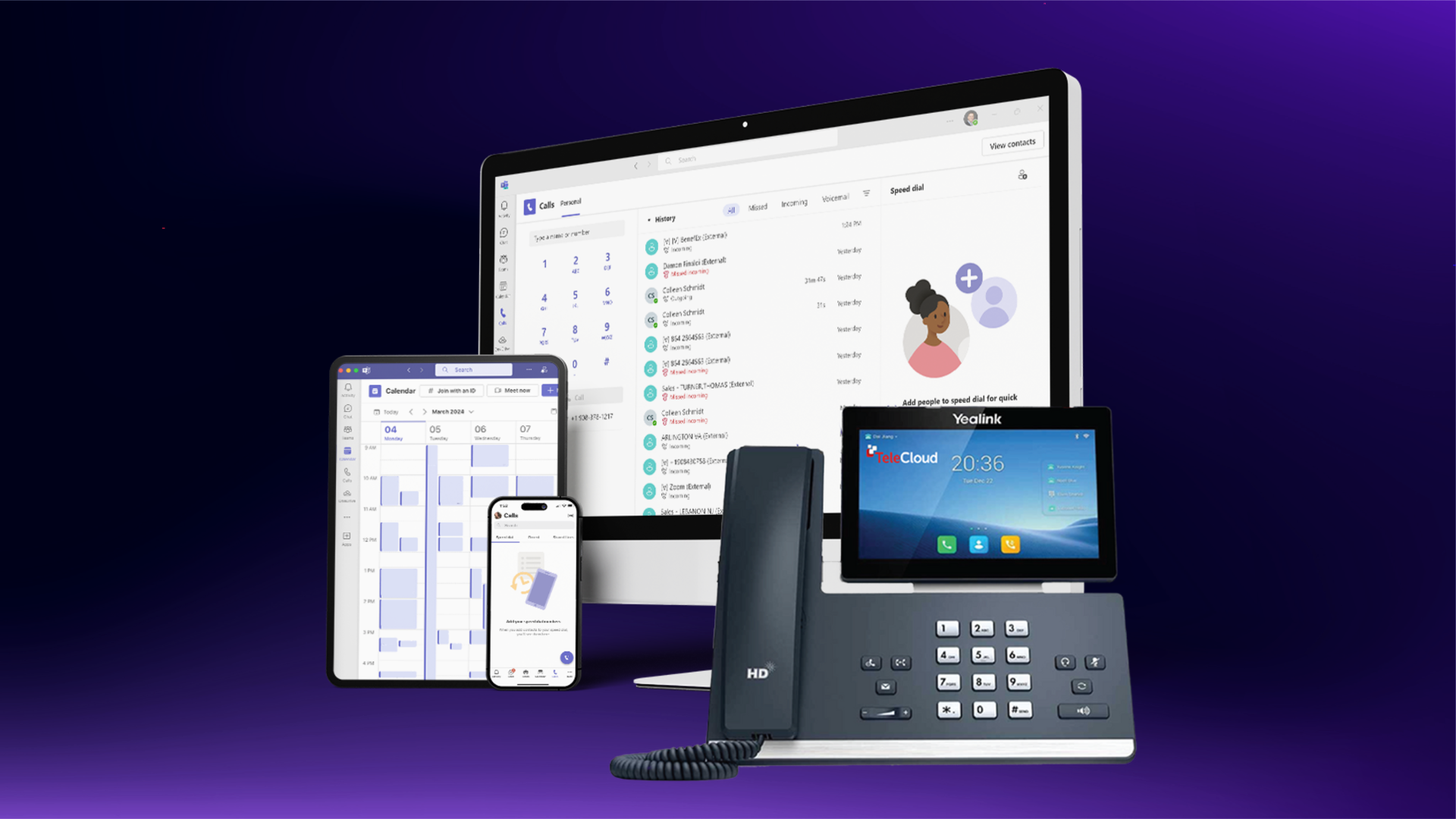Microsoft Teams Calling Plan vs. Operator Connect vs. Direct Routing
May 13th, 2025
4 min read
By Will Maddox

If your business runs on Microsoft Teams, you might be asking:
"Can we turn Teams into our full business phone system and is it the right move?"
You absolutely can.
But the path you choose and what you gain or sacrifice along the way depends on understanding the key differences between your options.
Today, businesses have four main choices for enabling external calling in Teams:
- Microsoft Teams with Calling Plan (Microsoft-managed phone numbers and service)
- Operator Connect (Connect with a Microsoft-certified telecom provider)
- Direct Routing (Bring your own SIP trunk and infrastructure)
- TeleCloud’s Managed Teams Integration (Simplified Direct Routing with full UCaaS features)
At TeleCloud, we've helped countless businesses navigate these decisions, whether they need full Microsoft integration, flexible UCaaS functionality, or a hybrid solution that delivers the best of both worlds.
In this blog, we'll break down each option clearly with no jargon and no hidden biases, so you can confidently choose the solution that fits your team's needs, your IT capacity, and your long-term goals.
What Are Your Options for Enabling Calling with Microsoft Teams?
1. Microsoft Teams Phone with Calling Plan (Microsoft Controls Everything)
Calling Plan is Microsoft’s simplest offering:
- Microsoft acts as your phone carrier.
- Microsoft issues and manages your phone numbers.
- Calls are routed entirely through Microsoft’s platform.
- Cost: Starting at ~$21/user/month
Pros:
- Fast, easy deployment.
- Centralized billing inside Microsoft 365.
- Great for very small businesses that only need basic calling.
Cons:
- Limited PBX functionality (basic voicemail, call hold, transfer).
- No advanced features like SMS, CRM integrations, or call centers.
- Microsoft ticketed support only, no quick help desk.
- Only available in select countries.
Best For: Small companies with fewer than 50 users that want basic calling, don’t need advanced features, and don’t mind relying entirely on Microsoft support.
Important Note: Sometimes, being "all-in" with Microsoft can make sense, especially for companies already deeply invested in Microsoft 365 that don't need any complex call handling or advanced features.
2. Microsoft Teams Operator Connect (Microsoft-Approved Carriers)
Operator Connect is the "middle-ground" solution:
- You choose a telecom carrier from Microsoft's certified list (like Momentum, CallTower, Fusion).
- The carrier connects directly to Microsoft Teams over an approved connection.
- You manage calling inside the Microsoft 365 admin center.
- Cost: Depends on provider/plan
Pros:
- Easier than Direct Routing to deploy.
- Some carrier flexibility (but limited to Microsoft’s partners).
- Slightly better support (depending on carrier).
Cons:
- Limited call features and no direct VoIP support like you get with UCaaS providers (TeleCloud, Vonage, etc.).
- Still dependent on Microsoft’s rules and licensing.
- Complex billing across Microsoft + carrier.
- Not ideal for businesses needing true call center solutions.
Best For: Companies with 100–500 users that have a strong internal IT team and want carrier flexibility but still want Microsoft to manage part of the process.
3. Microsoft Teams with Direct Routing (Maximum Flexibility, Maximum Complexity)
Direct Routing is the ultimate DIY setup:
- You connect your own SIP trunk to Microsoft Teams.
- You must deploy and manage a certified Session Border Controller (SBC).
- You’re fully responsible for call routing, uptime, and carrier relationships.
- Cost: Depends on provider/plan ($24.99/user/month with TeleCloud)
Pros:
- Total freedom to pick your carrier.
- Build completely customized call flows, routing, and features.
- Often cheapest at scale (if well managed).
Cons:
- High setup complexity.
- Ongoing IT management is needed.
- SBCs are expensive and require maintenance.
- Microsoft support won’t help you with SIP/carrier issues (but a good provider will).
Best For: Enterprises with 500+ users and dedicated IT telecom teams who want global flexibility and full control over voice environments.
How Does TeleCloud’s Direct Routing Teams Integration Compare?
TeleCloud provides a simple, managed Teams integration, without the Microsoft headaches.
With TeleCloud's Managed Teams Integration:
- You keep all the UCaaS features you love (business SMS, call queues, advanced routing, CRM integration).
- You call and manage communication inside Microsoft Teams.
- TeleCloud handles everything, no SBCs to manage, no SIP headaches.
- You still get fast, real human support, not a ticket black hole.
In short: You get the Microsoft Teams experience without giving up the powerful business phone system and service you already rely on.
Pros:
- Fast, painless deployment.
- Lower cost than Microsoft Calling Plan.
- Keep advanced telephony features.
- Real human support.
- No major change management burden on your team.
Cons:
- Some settings are managed through TeleCloud’s portal (very easy though).
- Not a "pure Microsoft" ecosystem, you get UCaaS service plus Teams experience.
Best For: Small and mid-sized businesses (20–300 users) that want to modernize calling inside Teams without losing advanced functionality, flexibility, or fast customer service.
Quick Comparison at a Glance
|
Option |
Setup Complexity |
Carrier Flexibility |
Support Experience |
Feature Set |
|
Microsoft Calling Plan |
Very Easy |
None |
Microsoft Ticket Support |
Basic (good for simple use) |
|
Operator Connect |
Moderate |
Microsoft Partners |
Carrier + Microsoft |
Moderate |
|
Direct Routing |
Very Complex |
Any Carrier |
Self-Managed |
Full (if custom built) |
|
TeleCloud Teams Integration |
Easy |
TeleCloud UCaaS |
TeleCloud Real Support |
Full UCaaS Feature Set |
Which Teams Calling Solution Is Right for You?
Choosing the right Teams calling setup isn’t just about making calls; it’s about choosing the level of control, flexibility, and support your business needs today and as you grow.
Here’s the simple truth:
If you’re a small team that only needs basic calling with minimal setup, Microsoft Calling Plan might be enough for now.
If you’re a mid-sized business with a strong IT department ready to take on telecom management, Operator Connect could work, but expect a learning curve.
If you’re a large enterprise with global offices and deep telecom expertise, Direct Routing offers maximum flexibility, if you're ready for the complexity.
But if you’re like most businesses: growing, dynamic, and focused on simplicity and productivity, TeleCloud’s Managed Teams Integration offers the best of both worlds:
- The familiar Teams experience your users already love
- The advanced calling features your business needs to scale
- Real, responsive customer support, not just ticket queues
- Simplified billing with predictable costs
- A lower total cost of ownership without losing flexibility
Bottom line: You don't have to sacrifice features, control, or service just to integrate Microsoft Teams into your communication stack.
With TeleCloud, you get a smarter, more flexible way to modernize your business phone system on your terms.
Ready to Make Microsoft Teams Your Complete Business Phone System? Schedule a Free Consultation with a TeleCloud Expert. Let's find the right path to simplify your communications and keep your team connected seamlessly and confidently.
Topics:





